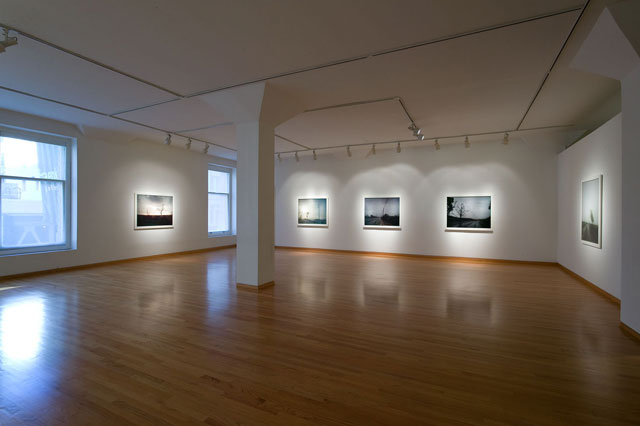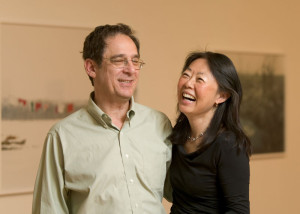Over the years, the gallery — along with 49 Geary housemates Fraenkel and Robert Koch — has also been instrumental in integrating photography into the contemporary art landscape. Sandra Phillips, SFMOMA’s Senior Curator of Photography, says, “The Wirtzes were very, very interested in photography, but they were not exclusively a photography gallery. Because they were open to photography, because they showed a lot of work by photographers as well as by all sorts of other artists, they helped to lessen the marginalization of photography. I think they were responding to what was happening here in the Bay Area. Here we have wonderful artists who work in all media, including (some would say especially) photography.”
The Wirtzes claim that showing photos alongside paintings and sculpture happened organically. Early on, they found themselves with a small collection of works by Laszlo Moholy-Nagy. They had a handful of photographs, an assortment of prints and one painting, which was a real discovery, but they didn’t have enough of any one medium to mount the show. So they decided to show what they had, which apparently was not done back in the day. Since then, the gallery has continued to resist definition, which Stephen attributes to “non-hierarchical thinking.”
As a collector, Stephen tends to find things that people aren’t looking at or for. Things that are “extremely layered, yet ignored because they don’t fit into the economic hierarchy of the art world. But that leaves them open for me to find and for me to go into that corner and really look at things that nobody else seems to be looking at, which are oftentimes much richer than things that aren’t being ignored, that are being featured.”
Which is kind of like young Bay Area artists for Connie. “You see somebody’s work and nobody knows who they are, but because no one is looking, you get the chance to look deeper,” she says.
Indeed, Frish Brandt says, “Stephen and Connie helped lay the groundwork for the San Francisco art community 35 years ago.” Robert Koch adds, “They championed local artists and cultivated the local art community. They represented a strong group of talented artists and consistently had a strong exhibition program.”
Stephen is also proud of the little-known and seldom-trumpeted fact that the gallery has represented so many great female artists over its 30-plus year history. Off the top of their heads, Stephen and Connie name a handful of women artists (Laurie Reid, Kathryn Van Dyke, Catherine Wagner, Ulrike Palmbach, Lucy Puls, Barbara Crane, Sandra Shannonhouse, Magdalena Abakanowicz, Melanie Pullen, Catherine Spence) they were proud to represent, but know there have been many more. They discovered Deborah Oropallo, who describes the gallery as a “second family,” while she was a grad student at Berkeley. Oropallo says, given all the work it takes to run a gallery, she admires the consistent quality of the work found at Wirtz. She adds, “I must sincerely say that I love the work of every single artist the Wirtz Gallery represented.”
When I press them, the Wirtzes admit the show they remember most vividly is one they mounted in 1979. They had helped Richard Avedon secure an exhibition at the Berkeley Art Museum, so he offered them the opportunity to concurrently show some of his work in the gallery. True to form, they didn’t choose the (more commercially viable) fashion photos. Instead they asked to see Avedon’s latest work, which was three different images of Francis Bacon, two single portraits and one with the two portraits combined. They filled the gallery with multiples of these three images in various sizes. The show was conceptually related to Muybridge, making the gallery into a whole world of Francis Bacons confronting the viewer. Connie and Stephen had conceived it on their own and, when Avedon saw it, he said, “That’s brilliant.” Stephen remembers, “It was, actually, brilliant. I’m not saying we are, but it was. And that was the show that I still look back on — collaboratively, the artist, the two of us — it was (“exciting” chimes Connie) — it was amazing.”
Since then, the couple has exhibited other photo greats, such as Paul Schiek, Chris McCaw, Alec Soth, Lewis Paltz, Doug and Mike Starn, Masahisa Fukase, Irving Penn, alongside locals Jim Goldberg, Larry Sultan, Todd Hido, Doug Rickard and most recently Sean McFarland, among others.
When most galleries defined themselves by a particular medium, Stephen and Connie preferred to mix things up. You never knew what to expect walking into their dramatic, beautifully lit space, which faces Geary Street and has a long bank of windows down one side of the main gallery, or who you’ll find.
The best stories are like photographer Melanie Pullen’s. Her first visit to the gallery was to see a Starn Twins show, which had already been taken down by the time she arrived. She wandered around feeling disappointed and then encountered Stephen, who took the time to unearth images, giving her a personally guided tour through the work.
In fact, this was not an unusual occurrence. Even though Stephen seldom remembered who I was, he would often invite me into his office to show me his latest collection and seemed to relish explaining where things had come from and what they meant. McFarland says this is what made Stephen Wirtz Gallery so special. “The Wirtzes were so generous with their time and willing to talk with you about the work. Whether you were a 23-year-old interested graduate student or a collector with lots of money, they always seemed to be very equal with how they treated people. I always admired that quality.”
During Pullen’s first encounter with Stephen, she mentioned that she was a photographer and that her Fashion Victims series was showing at Ace Gallery in Los Angeles. Stephen took note and three months later Pullen was showing at Wirtz. McFarland had a similar experience, securing a solo show just seven weeks after a studio visit with the Wirtzes. This is not usual practice for an art gallery, which would normally have its exhibition schedule locked at least a year into the future. When I asked the Wirtzes if leaving space in their schedule to react quickly to new discoveries was part of their philosophy as gallerists, they responded that it wasn’t intentional, it was just something that happened. “We aren’t good business people,” says Connie. Stephen modifies that statement slightly: “We’ve never been known to be good business people.”
Pointing out another thing that will be missed, Catherine Wagner says, “Connie has this very dry sense of humor. She was always telling stories about the ‘70s and ‘80s. Sometimes I would get lost in where we were going. Both Larry Sultan and I one time joked that her telephone calls were yet another creative act of the Wirtz Gallery.” Connie’s phone calls, which I experienced first-hand while scheduling the interview for this story, were mentioned several times. What I loved about them was how they revealed the inner workings of a creative mind that finds connections in pretty much everything and feels compelled to explore them. Connie is all jazz.
When I speak with the Wirtzes about the reason behind their closure, they tell me that the catalyst was a large rent increase. This isn’t news, many galleries have vacated 49 Geary after rents more than doubled in recent years. The building has gone from a peak of about 18 galleries to just a handful today. In fact, folks once sneered at what they called the “art mall.” I wonder if they are still sneering today…
And then Stephen talks about the nature of time having changed. He says, “Art is about time. It takes time to make it. It takes time to grow into it. It takes time to see it. It takes time to connect to it. It takes time to live with it. And I think people’s use of time is different now. It just feels like people are feeling the need to economize with their time, use their time in some efficient manner and I don’t think an interaction with art is efficient.
“It’s not that people are not coming to the gallery because they don’t like art; they don’t want to spend the time. So they go to the art fairs, or they go to the Internet, or the museum, because all of those are more efficient uses of time. I think that culture involves an agreement to spend time.”
This is a complex thought. We are all so busy figuring out what we have to do next and interacting with what someone just thought and shared a moment ago that there is no time left for the present. And so the thought of finding, securing and building another space that would end up a stage wherein no one appreciates the set was just too much for the Wirtzes to contemplate. For the first time in their lives, they say they do not know what they will do next.
When I ask about the funniest thing that ever happened in the gallery, Connie says that funny things happen every day. “Though,” she adds, “what I think is funny is usually only funny to me.” Stephen says the funniest thing about the gallery is that they survived as long as they did. “We have both had the luxury and paid the price of being ourselves,” he adds.
My wish for the Wirtzes is that they become free of space, but continue to share their vision of art and life more often in more places. The Wirtzes don’t have to be missed because they aren’t going far, it will just be more difficult to drop in for a visit.



